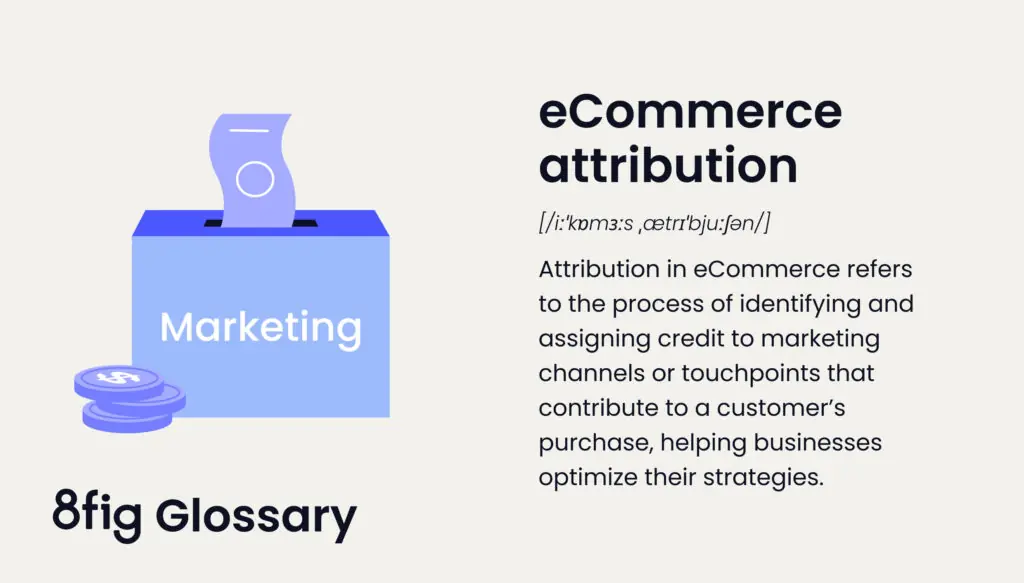Boost your cash flow with 8fig.
Definition
Attribution in eCommerce refers to the process of identifying and assigning credit to marketing channels or touchpoints that contribute to a customer’s purchase, helping businesses optimize their strategies.
What is eCommerce attribution?
eCommerce attribution refers to the process of identifying and assigning credit to the various marketing channels, ads, and customer interactions that contribute to a sale. In an era where shoppers engage with brands across multiple platforms – social media, search engines, email, and paid ads – understanding which touchpoints influence purchasing decisions is critical for optimizing marketing strategies and maximizing return on investment (ROI).
Attribution models help determine how credit is distributed across these touchpoints. Some models, like first-touch attribution, assign full credit to the customer’s initial interaction with a brand, while others, such as last-touch attribution, give credit to the final action before a purchase. More advanced models, like multi-touch attribution, consider the entire customer journey, weighing the impact of each engagement.
Without proper attribution, businesses risk misallocating marketing budgets – potentially cutting spending on channels that drive meaningful traffic while over-investing in those with weaker impact. By leveraging attribution insights, eCommerce sellers can refine their advertising strategies, improve customer targeting, and ultimately drive more conversions while optimizing costs.
How it works in eCommerce
eCommerce attribution helps businesses understand the effectiveness of their marketing efforts by tracking the touchpoints that influence customer purchases. With consumers engaging across multiple platforms – social media, search engines, email, and paid ads – determining which interactions contribute to sales is essential for optimizing marketing spend.
One of the biggest challenges sellers face is accurately measuring performance across channels. Without proper attribution, businesses may incorrectly assume that only the final interaction matters, while earlier touchpoints, such as product discovery through an Instagram ad or an email newsletter, may have played a crucial role in the decision-making process.
To address this, eCommerce brands use attribution models that distribute credit across the customer journey. For example, first-touch attribution highlights which channels drive initial brand awareness, while last-touch attribution focuses on the final step before purchase. More advanced models, like multi-touch attribution, assign value to multiple interactions, providing a comprehensive view of how different marketing efforts contribute to conversions.
Understanding eCommerce attribution allows sellers to optimize their marketing budgets, improve targeting, and scale their business more efficiently. By identifying high-performing channels and adjusting their strategies accordingly, businesses can ensure that every dollar spent on advertising generates maximum impact.
Benefits
- Optimized marketing spend: Attribution helps sellers identify which marketing channels drive the most conversions, ensuring ad budgets are allocated effectively.
- Improved customer insights: By analyzing the entire buyer journey, businesses can better understand how customers engage with different touchpoints before making a purchase.
- Higher conversion rates: Knowing which ads, keywords, or content generate sales allows sellers to refine their campaigns and improve targeting.
- Better ROI tracking: Attribution models help measure the true impact of marketing efforts, making it easier to scale successful campaigns while reducing wasted ad spend.
Stronger multi-channel strategy: Businesses can track performance across social media, search engines, email, and paid ads, ensuring they invest in the right mix of channels.
Challenges
- Attribution complexity: Customers interact with multiple touchpoints before converting, making it difficult to determine which one deserves the most credit.
- Inaccurate tracking: Ad blockers, cookie restrictions, and privacy updates can limit tracking capabilities, affecting data accuracy.
- Over-reliance on last-click attribution: Many businesses focus only on the final interaction, ignoring previous touchpoints that contributed to the sale.
- Cross-platform limitations: Attributing conversions across multiple devices (e.g., mobile, desktop) or platforms (e.g., Amazon, Google, Facebook) can be challenging without advanced tracking tools.
- High costs of advanced attribution tools: More sophisticated data-driven attribution models often require specialized software or expertise, increasing operational costs.
Might also interest you:
Examples and use cases
- Tracking the impact of social media ads: An apparel brand runs Facebook and Instagram ads to drive traffic to its store. Using multi-touch attribution, they discover that while most conversions happen after a Google search, their social ads played a key role in brand awareness—helping them optimize their ad spend more effectively.
- Optimizing email marketing performance: A home décor seller sends out a discount email campaign but sees that many purchases come from retargeting ads instead. By analyzing attribution data, they realize the email warmed up potential buyers, while the retargeting ads sealed the deal – prompting them to invest more in both strategies.
- Understanding the role of influencer marketing: A beauty brand collaborates with influencers on TikTok and YouTube. Attribution tracking shows that many customers watch influencer content first, then convert days later through a search ad. With this insight, the brand creates a retargeting campaign to capture more delayed conversions.
- Allocating budget across multiple ad platforms: A fitness equipment seller runs ads on Amazon, Google, and Facebook. Using data-driven attribution, they find that Google ads are best for discovery, while Amazon ads generate higher intent conversions. They shift their budget accordingly, maximizing ROI.
- Measuring the impact of organic content: An electronics store notices that customers who read their SEO-optimized blog posts are more likely to convert later. Attribution tracking helps them understand that educational content contributes to long-term sales, leading them to invest more in content marketing.
Pro tip
Use a multi-touch attribution model to get a clearer picture of your customer journey. Relying only on last-click attribution can lead to underinvesting in key discovery channels like social media, email, or influencer marketing.
Regularly analyze attribution reports to adjust your ad spend, content strategy, and retargeting efforts, ensuring every marketing dollar is working toward higher conversions.



